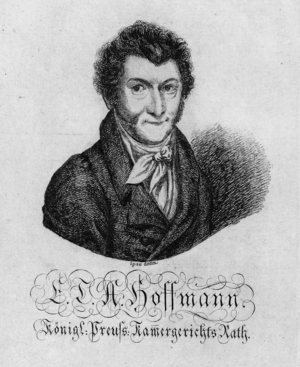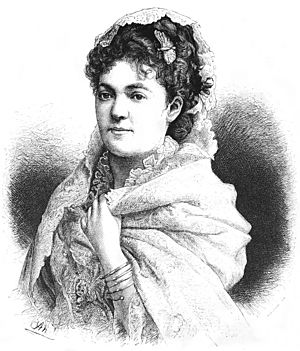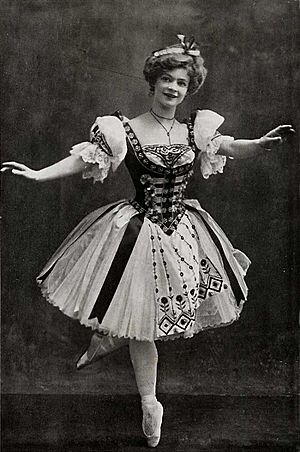Coppélia facts for kids
Quick facts for kids Coppélia |
|
|---|---|
| Choreographed by | Arthur Saint-Léon |
| Composed by | Léo Delibes |
| Libretto by | Arthur Saint-Léon Charles Nuitter |
| Based on | Der Sandmann (The Sandman), an 1816 fairy tale by E. T. A. Hoffmann |
| Date of premiere | May 25, 1870 |
| Place of premiere | Paris, France |
| Original ballet company | Théâtre Impérial de l'Opéra |
| Characters | Swanhilda Frantz Dr. Coppélius Coppélia |
| Designs by | Charles Gambon Édouard Despléchin Jean-Baptiste Lavastre Paul Lormier (costumes) Alfred Albert (costumes) |
| Setting | Village in Poland at the end of the 18th century |
| Created for | Léontine Beaugrand |
| Genre | Comedy |
| Type | Romantic ballet |
Coppélia ou La fille aux yeux d'email (meaning Coppélia or The Girl with the Enamel Eyes) is a very famous and often performed comedy ballet. It was created by Arthur Saint-Léon and Charles Nuitter. They based the story on an old fairy tale called Der Sandmann (The Sandman) by E. T. A. Hoffmann. The beautiful music for Coppélia was written by Léo Delibes, and Saint-Léon also created the dances.
The ballet takes place a long time ago in a village in Poland. The main characters are Swanhilda and Frantz, who are sweethearts. But Swanhilda worries that Frantz is interested in Coppélia, a mysterious girl who lives in the house of a dollmaker named Dr. Coppélius. Swanhilda soon finds out that Coppélia is actually a doll! Dr. Coppélius tries to use magic to bring the doll to life by taking Frantz's energy. Luckily, Swanhilda saves Frantz, and they live happily ever after.
Coppélia took three years to get ready for its first show because of many challenges. One big challenge was finding the perfect dancer to play Swanhilda. Finally, a talented sixteen-year-old dancer named Giuseppina Bozzacchi was chosen. The role of Frantz was played by a woman dressed as a man. The ballet first opened on May 25, 1870, at the Théâtre Impérial de l'Opéra in Paris. Coppélia was a huge hit and has been performed all over the world ever since.
Contents
The Story of Coppélia
Act I: The Village Mystery
The story of Coppélia begins in a small village in Poland during the late 1700s. Swanhilda and Frantz are young villagers who are in love. However, Frantz seems to be flirting with Coppélia, a strange girl who sits quietly in the window of Dr. Coppélius's house. Dr. Coppélius is a dollmaker. Swanhilda gets very upset about Frantz's behavior.
One evening, Dr. Coppélius leaves his house and accidentally drops his key in the street. Swanhilda finds the key. Curious, she opens his door and goes inside with her friends. Meanwhile, Frantz quietly sneaks up and puts a ladder against a window of the house, trying to get in. But Dr. Coppélius returns and chases Frantz away.
Act II: Inside the Dollmaker's Workshop
Inside Dr. Coppélius's workshop, Swanhilda and her friends look around. The room is full of amazing, life-sized dolls. Swanhilda soon discovers that Coppélia is also just a doll! Dr. Coppélius enters and is very angry, chasing most of the girls away. But Swanhilda manages to hide. Frantz then climbs through the window, and Dr. Coppélius welcomes him. The dollmaker needs a human's life force to bring Coppélia to life.
Coppélius gives Frantz a glass of wine, which makes the boy fall asleep. The dollmaker then performs a magic spell. He tries to bring Coppélia to life using Frantz's energy. But Swanhilda, still hidden, pretends to be Coppélia. She causes a lot of chaos in the workshop, destroying things and saving Frantz's life. Dr. Coppélius faints in shock as the sweethearts run away.
Act III: A Happy Wedding Day
The third act begins with a celebration for a new church bell. Swanhilda and Frantz, along with other couples, are getting married. The Lord of the Manor has given all the couples gifts called dowries. Dr. Coppélius arrives, very angry about his ruined workshop. He demands to be paid for the damage. Swanhilda bravely offers her own dowry to pay him back.
However, the Lord of the Manor tells Swanhilda to keep her dowry. He agrees to pay for the damages himself. The couples then enter the chapel to get married. The celebrations begin with a famous dance called the "Dance of the Hours." Different dances like "Dawn," "Day," and "Hour of Prayer" are performed. The newly married couples return, and everyone rejoices together.
From Dark Fairy Tale to Bright Ballet

The ballet Coppélia was inspired by E. T. A. Hoffmann's fairy tale Der Sandmann. But many changes were made to make the ballet much lighter and happier. For example, in Hoffmann's original story, the doll actually comes to life using the hero's life force. In the ballet, though, the doll stays a doll. Swanhilda stops Dr. Coppélius from bringing it to life.
Another big change is the ending. In Hoffmann's tale, the hero sees the doll in a vision and then falls from a tower to his death. But in Coppélia, the hero is saved by his sweetheart, Swanhilda. So, a happy ending replaces a sad and tragic one.
The creators of the ballet chose only a few ideas from Hoffmann's story. They kept Dr. Coppélius, the life-sized doll, and the young man who is confused between his feelings for the doll and his love for a real person. They set the story in a simple country village. Hoffmann's original story was set in a more serious city environment.
The overall feeling of Coppélia is cheerful and fun. The story is easy to follow. Its magical parts, like the dollmaker and his workshop, make Coppélia especially appealing to young audiences.
How the Ballet Was Created
Coppélia is one of the first ballets about bringing a doll to life. Charles Nuitter started writing the story for the ballet in late 1866 or early 1867. He had a young dancer named Léontine Beaugrand in mind to play Swanhilda. Then, Léo Delibes began writing the music.
As rehearsals started, the director of the Paris Opéra wanted a famous dancer to play the main role of Swanhilda. Even though Beaugrand was a lovely dancer, she wasn't famous enough yet to attract large crowds. So, Adèle Grantzow, a German ballerina from Moscow, was hired instead. The choreographer, Saint-Léon, was also very busy working in both France and Russia. This meant he couldn't focus completely on Coppélia. Because of these things, the ballet was rehearsed for three long years.
Then, Coppélia lost its star when Grantzow got injured and had to go back to Russia. Léontine Beaugrand was again passed over for the role. Instead, Giuseppina Bozzacchi, a sixteen-year-old dancer who was already part of the ballet company, was chosen to play Swanhilda.
The First Performance
Coppélia had its first performance on May 25, 1870, at the Théâtre Impérial de l'Opéra in Paris. Giuseppina Bozzacchi danced the role of Swanhilda. Eugénie Fiocre played Frantz, and Francois-Édouard Dauty was Dr. Coppélius. For the doll Coppélia, a real mechanical doll was used on stage. Because a woman played Frantz, a special dance for two people (a pas de deux) between Swanhilda and Frantz wasn't possible in the original show. Despite this, the ballet was a huge success!
Bozzacchi performed in eighteen shows of the ballet before the theater closed because of the Franco-Prussian War. Sadly, she died of a fever during the Siege of Paris on her seventeenth birthday, November 23, 1870.
When the theaters reopened in 1871, Léontine Beaugrand finally got to play Swanhilda and was very successful. The role of Frantz continued to be played by a woman dressed as a man at the Paris Opéra until the 1950s.
The Music of Coppélia
Coppélia was the first full ballet score written by Léo Delibes. He learned from Adolphe Adam, who composed the famous ballet Giselle. Delibes, like his teacher, used special musical themes called leitmotifs to represent characters and places in Coppélia. For example, Swanhilda has a special waltz tune, and Frantz has two themes. Dr. Coppélius has a dry, quirky tune, and the doll has an odd, small musical idea. The village square has busy, lively music, while Coppélius's workshop has more mysterious, spooky music.
Delibes loved the folk music of eastern Europe. He included a Polish dance called the mazurka and a Hungarian dance called the czardas in the ballet. Delibes's czardas was the first one ever written for a ballet! Other types of folk music in the ballet include a Spanish bolero and a Scottish jig. In the original ballet, Frantz didn't have a solo dance because a woman played his part. A pas de deux for Frantz and Swanhilda also wasn't possible for the same reason. The pas de deux you see in the ballet today was added later by Marius Petipa. He included it when he changed the music for his 1884 production in St Petersburg.
Many people describe the music as "lively" and one of the best ballet scores since Adam's Giselle. Before Delibes, ballet music was often just simple background noise. But Delibes's Coppélia music was colorful, had many different rhythms, and was richly orchestrated. It set a new standard for how ballet music should be written.
Other Performances Around the World
Coppélia in France
Coppélia has always been, and still is, very popular. The Paris Opéra Ballet has performed Coppélia 711 times over 90 years! In 1996, Patrice Bart created a new version of the ballet. He went back to Hoffmann's original fairy tale for some ideas. This new version gave the characters more depth and even brought back one of Hoffmann's original characters, Professor Spalanzani. Bart also used music from Delibes's operas for his new production.
Coppélia in England
Coppélia was first performed in England at the Empire Theatre in London on May 14, 1906. Adeline Genée danced the role of Swanhilda. The Royal Ballet first performed Coppélia in 1933. This version was based on an older revision from the 19th century. Dame Ninette de Valois danced Swanhilda in this 1933 show. Later, in 1954, de Valois created her own version of Coppélia, based on the Russian productions.
Coppélia in Russia
Coppélia was first performed in Russia in 1884. Marius Petipa changed the original dances for this production. In 2009, Sergei Vikharev recreated Coppélia for the Bolshoi Ballet. He used old records from the Mariinsky Theatre from 1894 to make it as close to the original as possible. This version had new designs and featured 24 dancers in the "Dance of the Hours." Vikharev's version was also performed in London in 2010 during the Bolshoi's summer tour.
Coppélia in the United States
Coppélia was first performed in the United States by the American Opera Company at the Metropolitan Opera in New York City on March 11, 1887. Marie Giuri danced Swanhilda, and Felicita Carossa danced Frantz. The famous ballerina Anna Pavlova made her American debut as Swanhilda at the Metropolitan Opera on February 28, 1910. Later, in 1974, George Balanchine and Alexandra Danilova created their own version of Coppélia. Their production used the traditional story for the first two acts but changed the third act's "Dance of the Hours" into a general celebration of ballet.
Coppélia in Australia
Coppélia was first performed in Australia in Melbourne in 1913. Adeline Genée and dancers from the Imperial Russian Ballet performed the ballet on the first night of their Australian tour. This version was put together by Alexandre Volonine and included extra music.
The first Australian-made production premiered in 1931 in Sydney, Australia. This show was designed and staged by Louise Lightfoot and performed by the First Australian Ballet. Since then, Australian ballet fans have seen parts of the ballet, as well as full-length productions, by both Australian and international companies.
Coppélia in China
A version of Coppélia was staged by the National Ballet of China in Beijing in 2002. The dances for this show were created by Par Isberg. The production opened at the Tianqiao Theatre on May 1, 2002. Wang Qiming played Coppélia. This production stayed close to the original story but made it simpler and more modern. The costumes included jeans for the men and short, tight skirts for the women. Some of the women even danced on roller skates!
Images for kids
See also
 In Spanish: Coppélia para niños
In Spanish: Coppélia para niños





